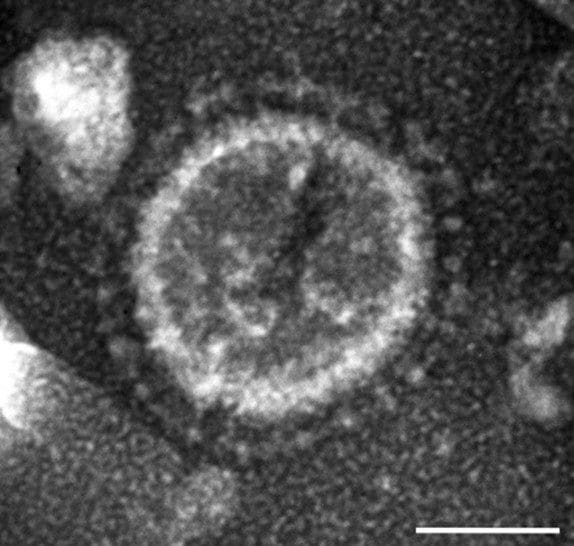
Get A Testing Quote
Porcine Epidemic Diarrhea (PED)
| Virus | Porcine epidemic diarrhea virus (Coronavirus) |
| Structure | Enveloped |
| Genome | Single-stranded RNA virus |
| Family | Coronaviridae |
| Primary Host | Pig |
| Disease(s) Caused | Porcine epidemic diarrhea |
| Symptoms | Diarrhea, vomiting and dehydration |
| Potential Complications | Death of newborn piglets |
| Transmission Mode | Oral contact with contaminated Feces |
| Sites of Community Outbreaks | Farm, pig collection points, slaughter facilities, transportation vehicles |
IMPORTANCE OF PORCINE EPIDEMIC DIARRHEA VIRUS
Porcine epidemic diarrhea (PED) virus is an enveloped member of the genus Alphacoronavirus in the Coronaviridae family. Its genome consists of a single positive-sense strand of RNA. PED virus is a disease caused by a coronavirus that occurs only in pigs.
PED was first observed in Europe in 1971. The coronavirus-like strain CV777 was isolated from pigs exhibiting diarrhea in a PED outbreak in Belgium in 1976. During the 1970s and 1980s, the virus spread throughout Europe. However, over the course of the next decade, the number of PED outbreaks decreased markedly in the region. Only a few severe outbreaks have been reported since the 1980s in Europe. Nevertheless, PED has become an endemic disease in Asian pig farming countries such as Korea, China, Vietnam, Japan, the Philippines, Taiwan, and Thailand.
Until 2013, PED was thought to have been restricted to Asian countries. However, an outbreak of PED virus occurred in the United States in Iowa in April 2013, and within one year it spread to both Canada and Mexico. The PED virus strain isolated in the United States was genetically related to the Chinese PED virus strain reported in 2012. Interestingly, the Korean and Taiwanese PED virus strains isolated after the US outbreak were genetically related to the US PED virus strain.
Porcine epidemic diarrhea (PED) virus infects the cells lining the small intestine in pigs causing severe diarrhea and dehydration. The virus is not known to be zoonotic, hence it poses no risk to other animals or humans. It also does not pose any risk to food safety and hence pork remains completely safe to eat.
THE IMPORTANCE OF DISINFECTION: SURVIVAL OF PORCINE EPIDEMIC DIARRHEA VIRUS ON SURFACES AND TRANSMISSION POTENTIAL VIA FOMITES
PED virus is transmitted by the fecal-oral route (oral contact with contaminated feces). The most common sources of infected feces are pigs, trucks, boots, clothing, or other fomites. Older pigs generally get sick and lose weight after being infected, whereas newborn piglets typically die within five days of contracting the virus. It is important to contact a veterinarian when diagnosing the disease and to enhance biosecurity procedures in case of an outbreak.
The incubation period is approximately 12-36 hours and the disease lasts for 7 to 14 days. The survivability and transmission of the virus are enhanced in cold weather. Research has shown that it may be possible to inactivate PED virus in the presence of feces by heating trailers to 71°C for 10 minutes or by maintaining them at room temperature (20°C) for at least 7 days.
The virus is easily killed by phenolic, chlorine, or iodine-based disinfectants or peroxides. Several disinfectants such as formalin, sodium carbonate, lipid solvents, and strong iodophors in phosphoric acid have been demonstrated to effectively inactivate PED virus.
REFERENCES
PR Thomas et al. Department of Veterinary Diagnostic and Production Animal Medicine, Iowa State University. “Evaluation of time and temperature sufficient to inactivate porcine epidemic diarrhea virus in swine feces on metal surfaces.” March and April, 2015: 84-90
Kent Schwartz and Rodger Main et al. DVM Iowa State University Veterinary Diagnostic Laboratory. “Porcine epidemic diarrhea virus: FAQ and survival tips.” Jul 29, 2013. Web.
Snelson, H. et al. American Association of Swine Veterinarians presentation to the Pork Management Conference. “Comprehensive Discussion of PED virus.” June 19, 2014. Web
USDA. “Porcine epidemic diarrhea virus” [cited on 2022 May 07]. Web.
Porcine-epidemic-diarrhea-ped. Article 345.2013[cited on 2022 May 07]. Available from https://www.thepigsite.com/
PEDV, WhatIsIt.2013 [cited on 2022 MAY 07]. Available from http://nationalswine.com/library/downloads/pedv/
Porcine_epidemic_diarrhea_virus.[cited on 2022 May 07]. Available from
Image from: Source:
Share

